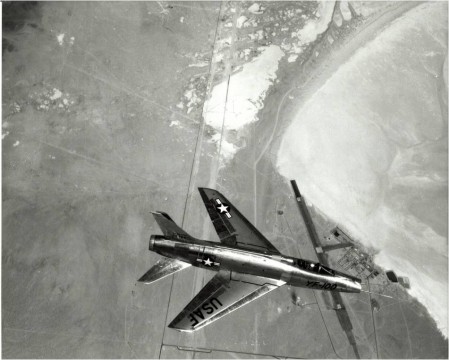Fifty-nine years ago this month, the USAF/North American YF-100A Super Sabre air-superiority fighter made its maiden flight with North American test pilot George S. Welch at the controls. During this initial test flight, the Super Sabre exceeded the speed of sound. The North American F-100 Super Sabre was the successor to the fabled F-86 Sabre fighter. The Super Sabre holds the distinction of being the first of the 1950’s era Century Series aircraft. It was also the first USAF production aircraft capable of flying supersonically in level flight. A total of 2,294 copies of the Super Sabre in 18 variants were produced over an operational lifetime that spanned 25 years. The air forces of the United States, France, Denmark, Turkey and the Republic of China (Taiwan) flew the aircraft affectionately known as “The Hun” by its pilots. The YF-100A was the initial version of the F-100. Two copies were produced. Ship No. 1 (S/N 52-5754) first flew on Monday, 25 May 1953 at Edwards Air Force Base, California. The aircraft performed well and hit Mach 1.03 on this first flight. The Super Sabre entered the USAF active inventory in late 1954 and set a number of speed records early in its operational life. The type won the Bendix Trophy for flying 2,020 nm at an average speed of 610.726 mph in September of 1955. The F-100 was also the first USAF combat jet to enter the Vietnam War. The USAF Thunderbirds flew the Super Sabre from 1956 to 1968. In spite of these notable achievements and distinctions, the aircraft was plagued by numerous design deficiencies and shortcomings that had to be corrected before the type reached an acceptable level of maturity. Particularly vexing were roll inertial coupling issues at high speeds and pitch-up tendencies at low speeds. Indeed, the aircraft had a deserved reputation as a widow-maker starting early in its career. History records that 889 F-100 airframes were destroyed in mishaps of one kind or another. That translates to a stunningly-high loss rate of 38.75%. Soberingly, 324 pilots lost their lives flying The Hun. Progress in aviation sometimes comes at a very high price. The F-100 Super Sabre, unique in its day, now a relic of history, is a particularly profound example of this truism.
Make Your Career Soar


